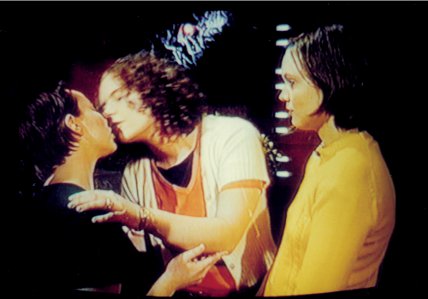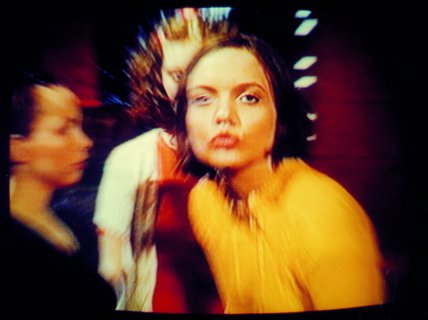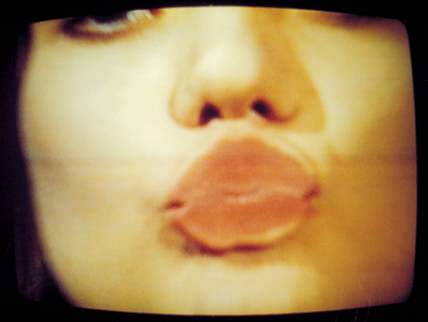|
|

Kiss

Kiss

Kiss, 1996
During the 1970’s video is mentioned on different occasion in writings as being part of actual art practice, but nobody seemed to be doing any in Iceland. I wanted to understand what seemed like a discrepancy between discourse and practice and discovered a landscape very different from that in the United States where an Icelandic violinist, called Steina, came one of the pioneers of video art. Before moving to New York in 1965, Steina and her husband Woody Vasulka spent a year in Iceland where they realized they had no future as artists – especially not Woody who was a filmmaker. In the 60’s film making was close to non-existing and the visual arts were not exactly sparkling with avant-garde atmosphere or revolutionary ideas about art and society – even though that was just about to change. But the change didn’t have much to do with video. It was about conceptual art and accepting the non-specificity of any medium that was to be considered a secondary asset to the artistic idea. Of course this is a summarized description but the young artists that managed to subvert the reign of post-war abstract painting that had dominated the local art scene since 1945 were drawn to conceptual art. These artists opened Gallery SUM in 1969 which marked a turning point in Icelandic art history. The next decade was characterized by experimentations with mixed media, performances, photography and film. The new spirit led to the foundation of an experimental art department at the School of Arts and Crafts in 1975 that was later renamed the New Art department. This is where the history of video begins - but without the video at first. During the next five years, students did all kind of experimentations, with environments, happenings, and performances and used 8 mm films and photography for documentation. The first video camera wasn’t bought by the school until 1979 and mostly used for the same purpose; to document performances.
But before I continue with the art, I would like to take you back to the early days of Icelandic Television as the history of video art and television are not totally unrelated. 50 years ago, at the dawn of Icelandic national television, a quarrel arouse in Iceland about the so called ‘Yankee’s TV’ which official name was the Armed Forces Radio and Television Service. It was run by the US army at the NATO Military Base in Keflavik, situated on Reykjanes Peninsula, about 50 km from the capital. The dispute started after the US army required more energy supply from the government for better quality broadcasting. The demand brought to mind an already existing fear that the Yankee’s TV might have a negative effect on the ‘spiritual life and culture of the Icelandic nation’. A number of politicians had been against this foreign television and now they thought that amplified energy meant that the army would be able to extend its zone of transmission and with it increase the risk of what we can call a ‘cultural contamination’. - The army had gotten a broadcasting licence from the government in 1955 but on one condition: it would have to restrict the broadcasting to the military base. This had never been actually feasible, but to cut the story short, in the end more energy supply was granted. This meant better quality transmission and better reception for Icelandic citizens living inside the range of the transmission zone including Reykjavik where more and more households owned a television set.
If we take a still closer look at the situation, this was of course in the middle of the cold war that opposed pro-Americans and communists. But we also have to remember that in 1962 Iceland was a very young Republic with a colonial past. From that point of view the quarrel about the army’s television reflected the conviction of many Icelanders at the time that it was important to preserve and protect the countries cultural identity and language from foreign influences. This fear came from the fact that Iceland had lost its independence in the 13th century to become a Danish colony and had only regained sovereignty in 1944. The struggle for independence started in the 19h century and had been nourished by a growing conscience of the nation’s identity to which language played an important role as Icelandic could be distinguished from Danish. So the need for preservation of a pure and uncontaminated language alimented a growing uneasiness toward the English language TV programs sent out by the US Army. Moreover this uneasiness was accentuated by the fact that in 1962 there was no native television in Iceland. The young republic was only too aware of its limited capacity to engage in television broadcasting which at the same time was inevitable. Eventually the quarrel accelerated the foundation of the Icelandic National Broadcasting Service which first broadcasting was on September 30th 1966. The national television was part of modernization the country but no less an act of cultural defence as the national TV’s main aim was to produce programs in Icelandic.
Now, the question is: Why should the foundation of the National Television matter to the history of video art? The anecdote of the establishment of the National TV is a reminder of the connection between art and technology. The development of new media art is conditioned by access to technology that outlines the artistic media practice. This access is in return affected by economics that shape both cultural practice and policymaking. In the early sixties the cost of running a TV was a hindrance for a young nation with a population of 180.000 and it took ten years of discussion to decide if a national Television should be founded. During approximately the same period, a company had tried to establish a cinematographic industry that failed. This is not surprising when you think of Iceland in 1950’ and 60’s. It was a developing country with few inhabitants and limited technological knowledge, no research industry and unstable economy with heavy inflation and fluctuating currency. The economic factors made the government put restrictions on importations that limited the possibility to buy and import technological devices. And for the commerce import was not profitable unless the goods attracted the general consumer.
So in a country with a small population, economic instability and non-existing technological industry artists had limited or no access to technological devices. Those external conditions had impact on both cinema and national television that was poorly equipped in its early days and delayed the arrival of video to Iceland in the decade following the explosion of video art in Europe and the United States. If the Portapak ever arrived to Iceland it never got into the hands of visual artists. When it comes to national television it did from the beginning put the emphasis on Icelandic cultural programs, which was encouraging, but at the same time, it was supposed be an answer to all ‘problems’. In other words, it got all the production funding, which left little space for films or video. But in the end the television did have a positive impact on Icelandic video art, only much later.
If I try to summarize what happened in the visual arts in the seventies it was nothing less than an artistic revolution were Gallery SUM and the New Art department in the School of Arts and Crafts played a major role as it made space for mixed media practice, including sound and film. Gallery SUM soon ceased its activities in but in 1977 the New Art movement inspired the funding of another artist run gallery called Sudurgata 7 (South Street 7) where 8 mm experimental films were shown on regular bases. Then in 1978 a society of artists was founded to establish the Living Art Museum that was run like a gallery and soon became the main exhibition space for progressive art of both Icelandic and renowned foreign artists. In 1981 the Living Art Museum organized its first performance and video exhibition, but according to a list of videos shown none of them were made by Icelanders.
If we go back to Steina and Woody Vasulka, and ask if they didn’t play any role in this history, the first sign of Icelander’s showing interest in their work goes back to a small newspaper article published in 1972 mentioning a successful video art exhibition in New York, at the newly established Kitchen. Seven years later, their exhibition at the Albert Knox Gallery, draws the attention of a reporter that writes a long article about the pioneering video work of the Vasulkas. But the Icelandic public still had to wait until 1984 to see Steina’s videos shown in Reykjavik. It was at an exhibition organized by Reykjavik Art Festival where Steina’s participation got quite an attention. She did show few tapes and the installation West, that could only be presented for three days. It needed at least ten monitors that had to be borrowed from different owners and they wanted them back after the opening week-end. Lot of the attention Steina got was focus on the technical aspect of her work and the strangeness of video art that both critics and reporters found difficult to explain. No art critic gave a review on Steina work, except Valtýr Stefánsson who was also a painter and wrote that he couldn’t judge it and honestly admitting that he lacked knowledge about this new art form. Then a journalist wrote that Steina’s installation had had huge success but thinks it’s because Icelanders are so easily seduced by new technology suggesting it leaves out the content.
In the 80’s the was another conversion in the local art scene, were New Art with its emphasis on performances, film and eventually video had a drawback. Video was only occasionally seen at exhibitions and almost eclipsed from the art scene. First of all the New Art department had been a subject of dispute both inside and outside of the School of Arts and Handicrafts. When the director that established the department left her position, her successor tried to shut it down. Student’s protested and the department continued its activities but only a year later or in 1982 the New painting became the new hot art form. The New Painting had its breakthrough exhibition The Breath of the Golden Beach in 1983 and in the following years neither art students nor artists gave much attention to films or video. Video was thought in a short introduction courses at the art school but nobody seem to been on specializing in that media. This may partly be due to the fact that working in video was difficult both financially, and in term of access to equipment.
Despite this unfertile ground video had a very slow ascension as an artistic medium during the 80’s. A handful of artists that had graduated from the New Art department between 1979 and 1983, left for Holland were they continued as postgraduate students at Jan van Eyck Academy in Maastricht. They were: Þór Elís Pálsson, Ásta Ólafsdóttir and Finnbogi Pétursson that soon turned his back on video and has dedicated his carrier on electronic sound and thus became a pioneer in sound art. At Jan van Eyck Thor Elís Pálsson became a video specialist and Ásta Ólafsdóttir made few videos that toured festivals in Europe. A fourth Icelandic artists studying in Holland at that time was Sigrún Harðardóttir, a painter that went to Rijksakademie van Beeldende Kunsten in Amsterdam.
All of the artists, except Finnbogi, had one or two exhibitions each in Iceland between 1982 and 1987 were they showed videos. Þór Elís Pálsson believed firmly in the future of video art and played a major role its promotion. He had returned to Iceland after graduation in 1982 where his technical skills were demanded. He became an employee of a new production company and then a producer at the Icelandic National Television. Sigrún Harðardóttir had two exhibitions in Iceland in 1986 and 1987. The 1986 exhibition was an event where three monitors were put on display outdoors, and attracted 300 spectators according to a local newspaper. But Ásta Ólafsdóttir who had shown her videos at the Living Art Museum with Joan Jonas in 1985 didn’t get mentioned by a very positive review written on Jonas videos by an Icelandic art critic. Ásta included videos again in her solo exhibition in 1986 that got mixed reviews reflecting the critic’s insecurity toward the videos even though they recognize they might have a certain quality.
So even though videos were shown on few occasions during those years, they were rare and sometimes went unnoticed. It didn’t matter all that much that Sigrun’s outdoor show had attracted 300 spectators; the work was simply not taken seriously by the art world. So it shouldn’t come as surprise if in 1987 a young filmmaker, when asked about the future of video answers: “I don’t think video has any future in Iceland.” But five years later, video art had its breakthrough when Þór Elís Pálsson got permission from the National Television to produce artistic videos shown in four episodes called ‘About Images’ broadcasted in the early months of 1992. At that time Þór Elis believe television was the right platform to show video art, and called up his old schoolmates, Finnbogi and Ásta, along with Thorvaldur Thorsteinsson that had newly graduated from Jan van Eyck and Alda Lóa Leifsdóttir, who collaborated with him on the program.
In the early 1990’s the School of Arts and Crafts, had hired its first skilled video teacher, an American artist named John Hopkins, which taught there between 1990 and 1995. His goal was to expand the practice of both video and photography that at that time was close to nonexistent according to him. This certainly prepared the ground for an event at the Living Art Museum where video appeared again with a blast in July 1993. This sudden explosion can be seen as direct consequence of a huge success Steina’s second exhibition in Iceland immediately had when opened in May 1993. This time Steina shows an installation called Borealis, at the National Gallery of Iceland which is acclaimed by all the Icelandic critics and both she and Woody participate in the Living Art Museum’s festival. The next few years lay a favorable ground for video. In 1994, a young artist named Kristrún Gunnarsdóttir, who had recently moved back to Iceland after studying in the United States, organizes the first specialized video art festival in Reykjavik. The festival and its artists became subject of another television program produced and presented by Þór Elís Pálsson. This time he produced six episodes that introduces both Icelandic and foreign artists, including Steina and Woody Vasulka. Then again in 1995, Kristrún’s organized her second and last video art festival and the same year, John Hopkins organized a video art program in collaboration with the American Cultural Institution in Reykjavík, the School of Arts and Crafts, and Electronic Arts Intermix in New York. In 1996 video art was shown once again on national television as part of the Reykjavik Art Festival, this time with videos from Electronic Art Intermix. The same year a group of four girls, all former students of John Hopkins ,calling themselves The Icelandic Love Corporation, had their first live performance on National Television were they kissed each other and then the screen or “the whole nation” as they said themselves. The performance of the Icelandic Love Corporation can be considered the symbolic beginning of a new era in the history of Icelandic video art as video has since been an important part of their practice. Video had become easily accessible and a real choice for artists living and working in Iceland.
|